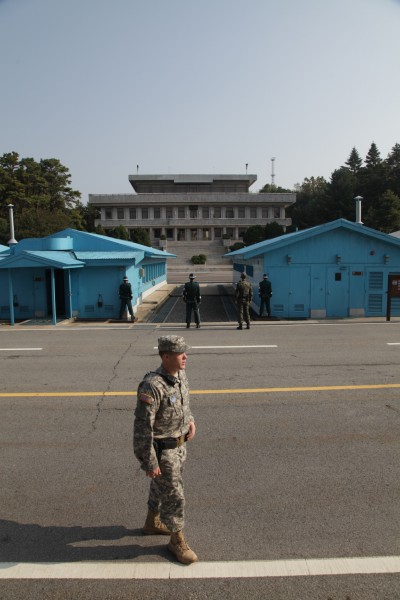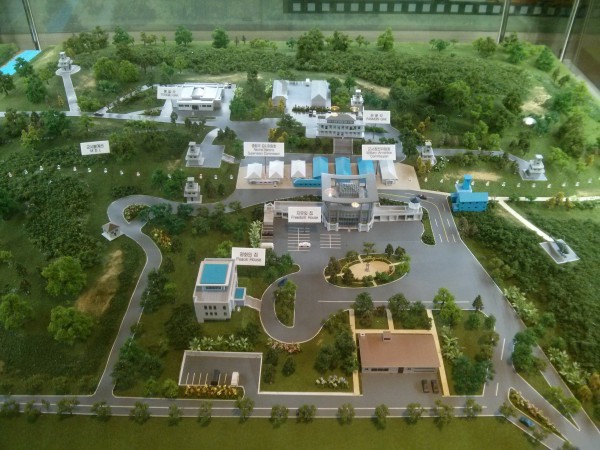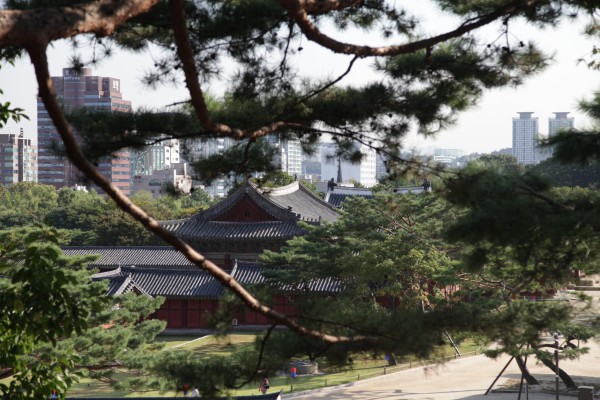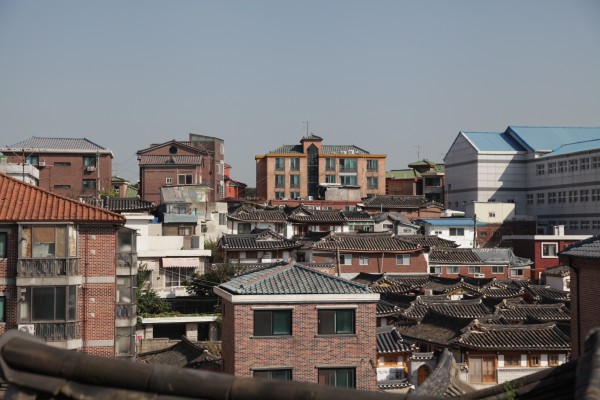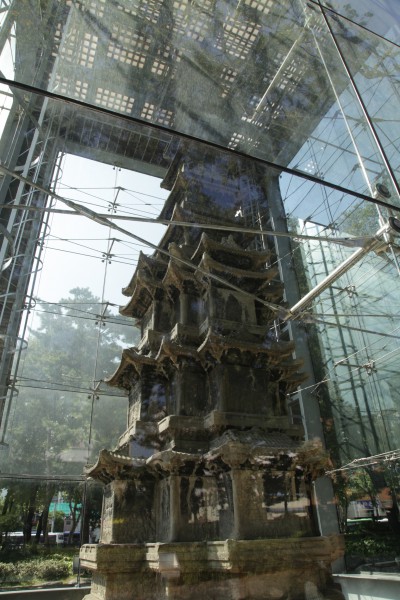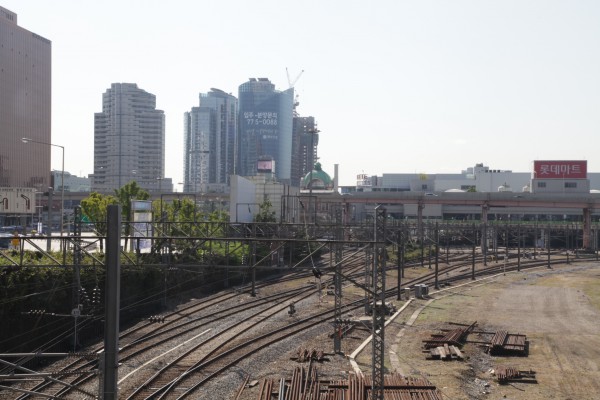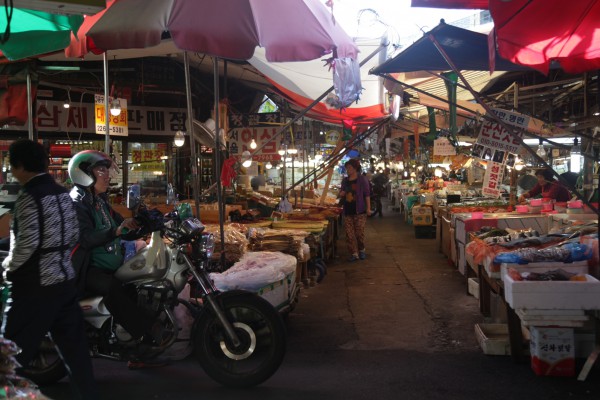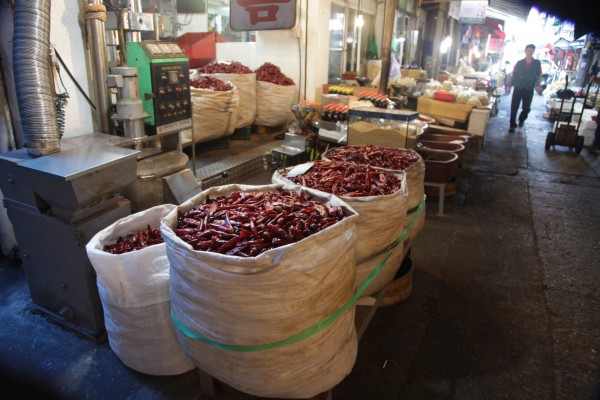Category Archives: Travel
Layout of the JSA
DMZ & JSA
The tour was from the USO in Itaewon, run by an organization called Koridoor. They had two buses full of people for the day’s tour. Most were Americans, but there were also some Koreans, a couple of Brits, three Indians, and a gaggle of (I think) Swedes. The tour leader for our bus was a Korean guy who’d spent ten years in the US Army in psyops.
We left at 7:30, and it took about 45 minutes to get to our first stop at Camp Bonifas, the last post before the DMZ. Along the way we drove along the river, which is lined with concertina wire and guard posts. Part of the source for the river comes from the north, so they have to guard against a river invasion.
At Camp Bonifas we were turned over to the US Army for the JSA portion of the tour. It started with a slide-show briefing on the history of the split, which was a little selective but generally accurate. Then we got on buses and rode into the DMZ.
After the initial barricades, the DMZ just looks like ordinary countryside. Rather like southern California. You don’t actually see the land mines. PVT Tekampe, who was in charge of our bus, said that animals occasionally explode, but he also told us that Vampire Deer were indigenous to the area, so he may have been having us on.
PVT Tekampe was an 11B (infantry) who’d been at Camp Bonifas for two months, straight out of Basic and AIT. He led us through the JSA, briefed us, and answered questions with that combination of competence and good humor that US military personnel seem to excel at.
We got off the bus at Freedom House, which is a big empty building originally built for families split during the war to reunite. It was never used for that purpose, though, so it’s now just something you walk through. Behind Freedom House is the famous row of buildings that straddle the military demarcation line (MDL).
We went inside the UNCMAC conference building and had a short briefing on what not do, such as taking pictures out the windows or getting too close to the ROK guards. (PVT Tekampe: “They’re not like Buckingham Palace guards. If you get closer than six inches, he will step back, and you will have a bad day.”) Then we milled around taking pictures, moving freely between the north and south sides of the room.
After a few minutes, we went out to the steps at the back of Freedom House while the people from the other bus went into the conference room. We stood on the top step and took pictures of the North Korean side while PVT Tekampe briefed us on what we were looking at.
When the other group finished, we rode back to Bonifas and visited…the gift shop. Of course there’s a DMZ-themed gift shop. There was a DMZ-themed gift shop at each place we visited on the tour. This was just the first.
After everyone had dropped some cash in the gift shop, they turned us back over to Koridoor to continue the tour.
A Resting Place
Coffine Gurunaru informs me:
Coffine Gurunaru wants to be a tree and a ferry in a river just like a place to rest. A good quality of coffee and the health benefits of wine will definitely make your body and your mind upgraded and even your pride in your life. Please take a deserved break at Coffine Gurunaru. Coffine Gurunaru is a resting place for you.
But I just got some espresso to go. I had to be at the USO by 7:00 AM for the DMZ tour.
Changgyeonggung
Rooftops
National Treasure No. 2
Onward
I spent a little time in the history museum, then walked back to Tapgol Park and saw National Treasure No. 2. Then I walked through Insadong to Bukchon Hanok Village, which is an area of older traditional houses that weren’t torn down when every other part of the city was modernizing. Now they’re in a sort of ritzy area and surrounded by art galleries. It’s kind of like Lombard Street in San Francisco, in that the residents constantly have throngs of tourists milling about in front of their houses taking pictures. Which is, of course, exactly what I did.
My feet and calves were sharply rebuking me by this time (especially since Bukchon Hanok Village is a very hilly area), but they are not the boss of me, so I went to Changdeok Palace, which is the only one of the palaces that’s a UNESCO world heritage site. UNESCO knows their stuff, palace-wise, I’m given to understand, but you can only see it with a tour, and I had missed the last English tour for the day.
So I stumbled next door to Changgyeong Palace, which doesn’t require a tour. It’s not as big as Gyeongbok Palace, but it’s in a much nicer park-like setting.
Then I went to Bong House and took a nap before going out for galbi.
I walked a total of about 20 miles over the course of the day.
Seoul Survivor
After the markets, I intended to make my way back to Insadong, but took a wrong turn somewhere and got solidly lost for about an hour. I’m still not sure where I was. At one point I was crossing some railroad tracks that were nowhere on my map. Eventually I was able to orient myself to the N-Seoul Tower, and when I stumbled across the History Museum, I could find my place on the map.
Note: The Rough Guide to Korea does not have very good maps.
Mega-Markets
Dongdaemun, Namdaemun, and Gwangjang are your go-to places if you’re looking for chili peppers, bolts of fabric, astro-turf, sheets of PVC, vegetables, cardboard boxes, knock-off t-shirts of American universities, surplus military clothing, live crabs, or traditional Korean outfits in children’s sizes.

